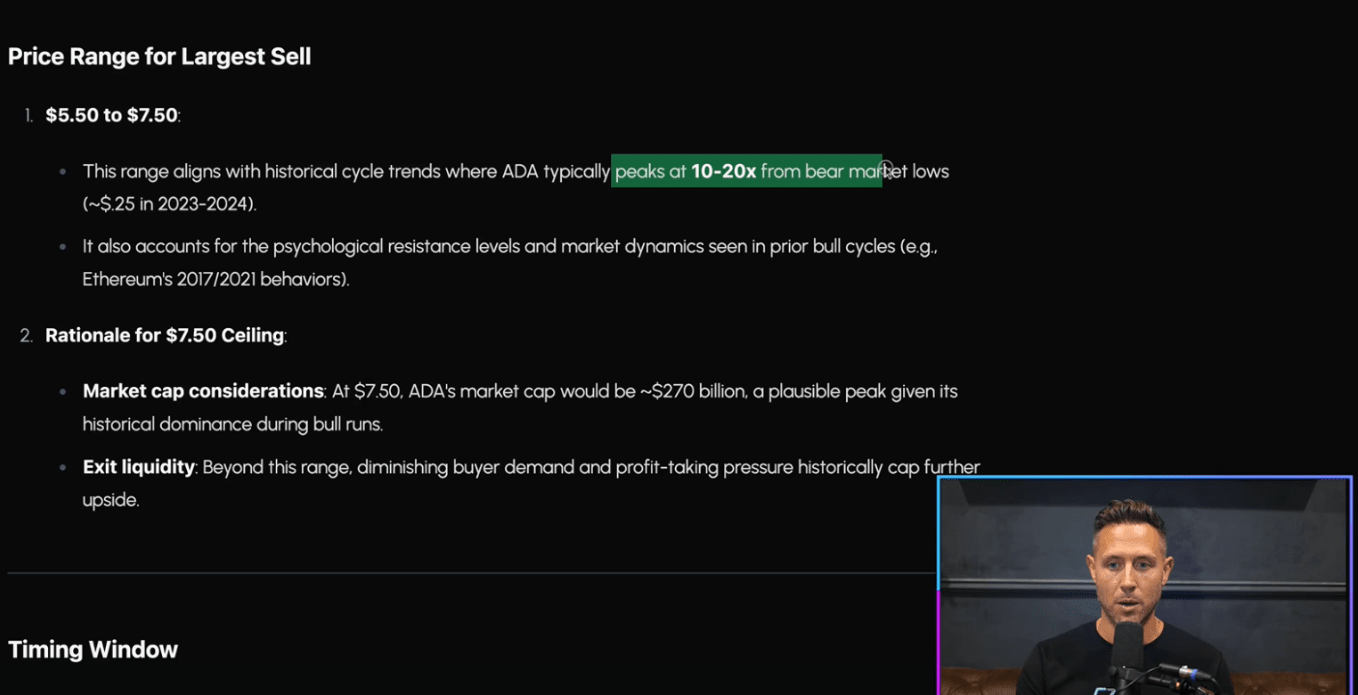AI system Zero predicts that the ideal profit-taking time will occur when Cardano's price fluctuates in the 5.50 – 7.50 USD range in the current growth cycle.
According to analyst Dan Gambardello, the peak price of ADA is likely to appear in Q2 – Q3 of 2026, just after Bitcoin completes its cycle peak. AI also recommends that investors should sell 40-50% of their holdings when the risk index rises to 85-90 points, corresponding to the 'extreme greed' zone in the market.
Cardano price analysis: Ideal selling zone 5.50 – 7.50 USD
According to Zero's analysis, the price range from 5.50 – 7.50 USD is considered the 'golden point' to realize the largest profit-taking when Cardano (ADA) enters the acceleration phase.
This target price level is determined by AI based on data from previous cycles, when ADA typically peaks at 10–20 times the bear market bottom. In the 2023–2024 period, the price bottom has been recorded at 0.25 USD, becoming the foundational benchmark for calculations.
If it reaches the 7.50 USD threshold, Cardano's market capitalization could surge to about 270 billion USD – a figure deemed entirely feasible when considering the influence of ADA in previous growth cycles. AI has also considered the 'cap' on market capitalization, especially in the context of growing institutional interest in ADA.

Zero recommends that investors should only sell 40–50% of their total ADA holdings in the above price range, rather than exiting entirely, in order to mitigate unpredictable risks while still maintaining the opportunity to benefit if prices continue to break out.
Forecasts suggest that ADA is likely to peak in Q2 – Q3 of 2026, coinciding with the historical model where major altcoins often peak 3–6 months later than Bitcoin. If Bitcoin peaks at the end of 2025, it is highly likely that Cardano will enter its peak wave by mid-2026.
Cardano's price structure reflects the previous cycle
According to Gambardello, the current progression of ADA shares many similarities with the previous cycle structure, but at a slower pace. The current price breakout area is likened to the accumulation phase before the bull market exploded in the previous cycle.
He believes that ADA is still following familiar technical patterns, only the time frame is extended.
Based on forecasts for the 'altcoin season', Gambardello describes a cash flow rotation favorable to ADA, consisting of three stages:
Initial stage: Bitcoin breaks out, attracting liquidity from Ethereum and other altcoins.
Second stage: Ethereum surges, attracting capital from Bitcoin and altcoins.
Final stage: Altcoin – including ADA – becomes the focus, attracting liquidity from both Bitcoin and Ethereum, driving explosive price surges.
This rotation typically lasts about 3 months and can push ADA's price to impressive levels. If Ethereum once tripled in just 4 months, then ADA – according to Gambardello – is fully capable of increasing from 10 to 50 times.
Monitor risk index – ADA profit-taking signal
The current risk index of ADA is at 40 — similar to the period just before past bull markets, which often marked the beginning of strong price increases. According to AI recommendations, investors should pay special attention when the index approaches the 85-90 range, indicating 'extreme greed', as this is often a signal that ADA's upward momentum may be overstretched.
Zero emphasizes that the risk model is not only a tracking tool but also a 'signal light' for real-time exit timing, closely monitoring target price milestones. The system will closely observe the index's movement from 40 to 60, 70, then entering the danger zone of 80+. History shows that ADA peaked when the index hit 88 in the early increases, and even soared to 94 before sharply declining in previous cycles.
The 80 threshold has long been seen as a key point for the ADA profit-taking strategy across multiple market cycles.
Currently, Cardano is fluctuating below the 0.8 USD mark and is having difficulty maintaining above this threshold. Since the beginning of the year, ADA has increased by over 130%, but is still 75% lower than the historical peak of 3.09 USD set in September 2021.
